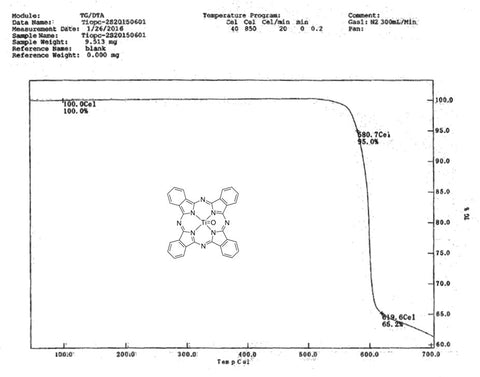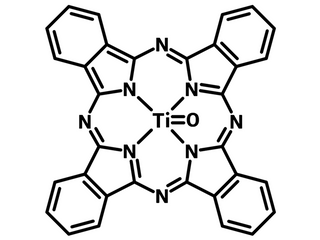Titanyl phthalocyanine, TiOPc
CAS Number 26201-32-1
Charge Transport Layer Materials, High Purity Sublimed Materials, Hole Injection Layer Materials, Materials,Titanyl phthalocyanine for OLEDs, OPVs and more
High-purity (>99%) and available online for priority dispatch
Titanyl phthalocyanine (TiOPc), CAS number 26201-32-1, the family member of highly photosensitive phthalocyanine compounds, is one of the most successful leading materials used in the photocopying industry. Among various phthalocyanine semiconductors, oxotitanium phthalocyanine in the crystal form of phase-Y (Y-TiOPc) has attracted particular attention due to its high photosensitivity to NIR light. The quantum efficiency of Y-form TiOPc for photo carrier generation is reported to be almost 100% in high electric fields[2].
Titanyl phthalocyanine is used as a water photo-oxidation agent and is built into sensors for NO2 detection. It has also been made into devices for of organic light-emitting diodes (OLEDs) and organic photovoltaics (OPVs) with photon to current efficiency (PCE) over 4% reported by using TiOPc as the light-harvesting dye and C60 as the electron acceptor [3-6].
General Information
| CAS number | 26201-32-1 |
|---|---|
| Chemical formula | C32H16N8OTi |
| Molecular weight | 576.39 g/mol |
| Absorption* | λmax = 692 nm (chlorobenzene) |
| Fluorescence | No data available |
| HOMO/LUMO | HOMO = 5.7 eV, LUMO = 3.9 eV [1] |
| Solubility | Chlorobenzene [7] |
| Synonyms |
|
| Classification / Family | Phthalocyanine derivatives, Charge generation layer (CGL) materials, Light-emitting diodes, Organic photovoltaics (OPV) |
* Measurable with an optical spectrometer
Product Details
| Purity |
Sublimed* >99% Unsublimed >98% |
|---|---|
| Melting point | 580.7 °C (5% wt weight loss - TGA) |
| Appearance | Dark purple powder/crystals |
* Sublimation is a technique used to obtain ultra pure-grade chemicals, see sublimed materials.
Chemical Structure
Device Structure(s)
| Device structure | IITO/NPB/CBP:Ir(ppy)3/BCP/Alq3:2 wt%TiOPc/LiF/Al [3] |
|---|---|
| Color | Green |
| Luminance @10 mA cm−2 | 7,800 cd/m2 |
| Power Efficiency@10 mA cm−2 | 4.2 lm W−1 |
| Device structure | ITO/PEDOT:PSS/BP2T/TiOPc/C60/Alq3/Al (160oC) [4] |
|---|---|
| Jsc (mA cm-2) | 9.26 |
| Voc (V) | 0.48 |
| FF (%) | 60 |
| PCE | 2.67 |
| Device structure | ITO (100 nm)/TiOPc (20 nm)/C60 (40 nm)/BCP (10 nm)/Al (100 nm) [5] |
|---|---|
| Jsc (mA cm-2) | 15.1 |
| Voc (V) | 0.57 |
| FF (%) | 53 |
| PCE | 4.2 |
| Device structure | ITO/TiOPc (20 nm)/C60 (40 nm)/BCP (10 nm)/Al [6] |
|---|---|
| Jsc (mA cm-2) | 3.99 |
| Voc (V) | 0.6 |
| FF (%) | 51 |
| PCE | 1.2 |
*For chemical structure information please refer to the cited references.
Characterization (TGA)

Pricing
| Grade | Order Code | Quantity | Price |
|---|---|---|---|
| Sublimed (>99% purity) | M701 | 500 mg | £190 |
| Sublimed (>99% purity) | M701 | 1 g | £310 |
| Unsublimed (>98% purity) | M702 | 1 g | £200 |
| Unsublimed (>98% purity) | M702 | 5 g | £800 |
MSDS Documentation
Titanyl phthalocyanine MSDS sheet
Literature and Reviews
- Enhancing the contrast and power efficiency of organic light-emitting diodes using CuPc/TiOPc as an anti-reflection layer, J. Li et al., J. Phys. D: Appl. Phys., 40, 2435–2439 (2007) doi:10.1088/0022-3727/40/8/004.
- Study of Carrier Generation in Titanyl Phthalocyanine (TiOPc) by Electric-Field-Induced Quenching of Integrated and Time-Resolved Fluorescence, Z. D. Popovic et al., J. Phys. Chem. B, 102 (4), 657–663 (1998); DOI: 10.1021/jp973188q.
- Enhanced carrier transport in tris(8-hydroxyquinolinate) aluminum by titanyl phthalocyanine doping, M. Ramar et al., RSC Adv., 4, 51256-51261 (2014); DOI: 10.1039/C4RA09116G.

